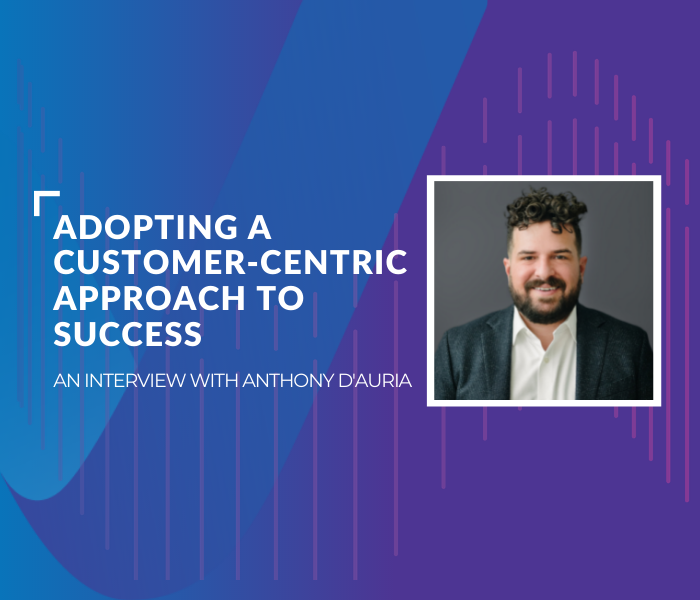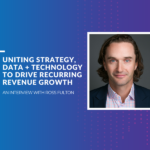A Customer-Centric Approach To Success
Putting your customers first should be your organization’s #1 strategic priority. With the domain growing over 736% in the past 5 years, Customer Success has become one of the top 10 fastest growing professions in the US (Gainsight, 2019). If your organization isn’t investing enough in your customer success organization, you may be missing out on key retention and expansion opportunities that accelerate recurring revenue.
When leading a late-stage organization, it can be challenging to align cross-functional teams with differing perspectives and priorities around a shared vision of the customer. Despite this, how do other enterprise leaders successfully accelerate an organization’s adoption of a customer-centric approach?
To answer this question, I spoke with Tony D’Auria, Customer Success Strategy Consultant at Valuize. Tony works closely with leaders from enterprise B2B software companies, including Splunk, HashiCorp, and VMWare, to help them build and scale their customer success strategies and operations. During our discussion, Tony offers his perspective on how other organizations can build lasting customer relationships and lead with a customer-centric approach to success.
Q: What was your first job? How did you get started in customer success?
“My first job out of school was with Blackberry, then called Research in Motion, as a technical writer, supporting the global data center management team and an internal PMO. I’ve hopped around different roles within the tech industry but landed in CS about 8 years ago at a company called Eloqua that was then acquired by Oracle.”
Q: What excites you about working in the customer success domain? How do you think the domain will continue to evolve from here?
“As a practitioner what excited me about customer success was the relationship building, and helping the people I build relationships with solve problems. I’ve had customers, and not just logos but actual individuals, that I worked with for over 4 years. Building those relationships and that trust, becoming an extension of their team, and seeing the results in their business based on that partnership is really rewarding.
To me, the evolution of customer success is in technology and data. What I’m seeing a lot of organizations pivot to is similar to what you see in the marketing and sales funnel – data and the supporting technology that can predict revenue, understand the digital body language of a customer and enable CS teams to act faster and with even more intelligence. The marketing and sales tech spaces have exploded over the past few years and I think more companies are recognizing that the type of engagement data those tools provide is hugely impactful to the post-sale experience. The pandemic shined a light on this and think as a result we will also see the investment in CS grow as well.
Q: In your experience, what have you seen as some key challenges that software organizations are facing when it comes to designing a customer success strategy?
“Customer success is everyone’s responsibility – and I see a lot of companies saying that, but not practicing that. I think many CS organizations struggle with getting the cross-functional buy-in to develop and deploy a strategy that weaves itself through the entire organization. A robust strategy is going to have involvement from sales, marketing and product along with customer success – but those teams have priorities, goals and mandates too. So creating and embodying that culture can be tough.
Another area I would say is a challenge is having the bandwidth to do the work. Customer Success has a wide mandate – implementation, CS, support – it’s a lot of ground to cover, and things move fast. There’s always a need to focus on the tactical, day-to-day, and sometimes that doesn’t leave room to sit down and fix the end-to-end. I worked for a VP who often used the analogy of changing the wheels on a car while it’s moving down the road. There’s a great video on YouTube where some people actually do it. I think it’s a great analogy that highlights the challenge of designing and deploying a CS strategy – it’s tough, it’s a lot of work, but it can be done.”
Q: Customer outcomes seem to be an increasingly popular term. Can you elaborate on the role that customer outcomes play in building a customer success strategy?
“Having defined customer outcomes in your CS strategy is a total game-changer. I could go on forever on this topic, but I’ll keep it brief! Having defined customer outcomes and tying them to the desired outcome of each customer is the key to establishing the value of your product. If you define this, and prescribe it at the point of sale, the point of renewal, and as your customer’s priorities shift, you can build a roadmap in how you’ll deliver your services and guide your customer’s use and adoption of the product. It gives you the goal and the ability to measure their success towards that outcome. It’s practically a recipe for renewal. And if these are defined for your organization, and prescribed to each customer, you’ve got a repeatable process for your CSMs to execute on, making their job easier and making everyone (including the customer) more successful.”
Q: What would you say are the top 3 most important components of a strong customer success strategy?
“Defined outcomes, access to data, and cross-functional support.”
Q: What’s your secret to creating a killer customer onboarding process? How do you recommend that CS professionals initiate this in their organizations?
“Starting the success plan during the sales process. There are a lot of components required to create a killer onboarding process, but if you have agreement with the customer regarding what they want and expect to achieve with your product and how to achieve it, the implementation team has a roadmap of how to educate the customer, configure their instance of the product and set them up for success. Having that common thread from sales, through implementation, to the CSM creates a really great experience for the customer and reduces the possibility of missed expectations.”
Q: How do you implement and optimize customer health monitoring programs? Are there any particular metrics you recommend tracking?
“The first step here is understanding what you want your customer health score program to do for you, and then choosing the metrics that will support that objective. Regardless of the objective, product usage data/usage of sticky features and engagement data are, in my opinion, critical. I like to expand on engagement and include things like, how often are we talking to this customer – and at what level of the organization? Have we been talking to the decision maker? Automate as much of this data as possible through tools like Gainsight and other data sources to help assess risk when going into a renewal cycle. I also think it’s important to track the CSMs sentiment of the account. Your CSMs are on the front line, talking to these customers every day. Their insights and perspectives are invaluable.”
Q: Customer data is such a critical piece of a CS organization. What role do you see data playing in an organization’s customer success strategy?
“It’s huge. As I mentioned before, there are so many insights that a team can gain from data. Data can help you understand how engaged your customer is, telling you when a customer is ready to expand, their likelihood to renew, or where there may be risks in their adoption of the product. Data allows your team to be extremely proactive. And it’s not just data that sits within CS – tap into what your marketing team is measuring, how your sales team qualifies a lead, how your product team analyzes usage. Connecting these data sources to your CS engine creates a powerhouse of insights.”
Q: One of your areas of passion and expertise is customer centricity. How do you help cross-functional leaders understand and align on the importance of building out processes from the customer’s POV?
“When I talk about this with clients it’s an immediate aha! moment. Companies often have a defined journey with all of the key milestones defined in their language. Awareness, consideration, adoption, expansion, renewal, etc. But that journey doesn’t speak to what the customer is doing, experiencing, or thinking. Once you take that journey and put yourself in the customer’s shoes, and define the journey as they experience, it’s so much easier to see those critical moments and identify where your organization may be falling short or missing the mark. After walking a client through a few examples of this, it’s really not a hard sell to get them thinking that way as well. It’s a really exciting part of working with clients because it’s so insightful.”
Bonus Q: What’s your favourite way to spend a Sunday?
“That’s a loaded question! There’s seasonality at play here and of course the pandemic. Right now since the weather is warm in Toronto I take my dog for a nice long morning walk on the beach with a coffee. When things start to open back up you’ll find me at a local brewery enjoying some afternoon sun on a patio.”
Driving A Customer-Centric Approach
Adopt an organization-wide customer-centric approach to customer success with Tony’s insights in mind:
- Value-based outcomes should serve as the foundation of your customer success strategy. These prescriptive, measurable outcomes should be defined at the point of sale, and used throughout the entire customer journey to deliver end-to-end value to your customers.
- Customer data is an essential element of a strong customer success strategy. Your team should be regularly collecting, analyzing and sharing customer data cross-functionally in order to track and optimize your customer success initiatives.
- Think about the customer journey from your customer’s POV. Rather than defining value from the perspective of your organization, take the time to understand how they define success in their language.
If you’re looking for more insights on scaling your CS strategy, read Tony’s latest article on how to build joint success plans that deliver a strong customer outcome strategy.





